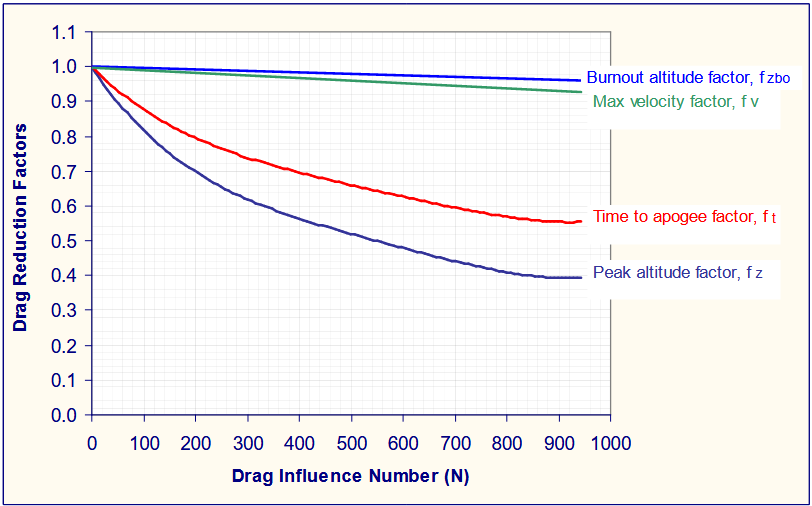The Program
Rocket Estimation, Altitude CalculatoR, or REACT, is a small program I wrote to give a quick and rough estimation of a rocket’s flight performance
The formulas are blatantly stolen from Richards nakka’s .PDF on the subject
First, the program itself

Now basically, all you need to do is enter some statistics, estimations or guesses about your rocket, and you get a estimate for how high it could go, how fast, and how long it would be in the air
The formulas used to get this are not the most accurate way to calculate altitude, but they are simple, so I used them
Speaking of which
The Maths
First, lets define some values
- let
 be the motor’s average thrust
be the motor’s average thrust - let
 be total impulse
be total impulse - let
 be the thrust time, which is calculated from
be the thrust time, which is calculated from 
- let
 be the rockets dead mass (no propellant)
be the rockets dead mass (no propellant) - let
 be the propellant mass
be the propellant mass - let
 be the average mass, decided by
be the average mass, decided by 
- let
 be the gravitational constant
be the gravitational constant - let
 be the drag coefficient
be the drag coefficient - let
 be the max rocket diameter
be the max rocket diameter
With that out of the way, lets see the first formula, which gives the burnout altitude with zero drag
![Rendered by QuickLaTeX.com \[ Z_{1} = \frac{1}{2} \left (\frac{F}{m}-g \right )t^{2} \]](https://denneth.nl/wp-content/ql-cache/quicklatex.com-54a880b7fb7488ab27db5d8aa4a36d57_l3.png)
(How all this works, why these formulas are used, and example calculations can be found better explained by nakka in his document)
From this, velocity at burnout can be calculated (with zero drag)
![Rendered by QuickLaTeX.com \[ V_{1} = \sqrt{\frac{2 \: Z_{1}}{m}\left (F - m \: g \right )} \]](https://denneth.nl/wp-content/ql-cache/quicklatex.com-e5f61459debe51e47c49676e0ae86d9b_l3.png)
Peak altitude can also be deduced (again assuming zero drag)
![Rendered by QuickLaTeX.com \[ Z_2 = \frac{F \: Z_1}{m \: g} \]](https://denneth.nl/wp-content/ql-cache/quicklatex.com-0337cfa463d4442a6965d3feaef0bc61_l3.png)
And lastly, time to apogee (zero drag, apogee being the highest point reached)
![Rendered by QuickLaTeX.com \[ t_2 = t + \sqrt{\frac{2}{g}\left ( Z2 - Z1 \right )} \]](https://denneth.nl/wp-content/ql-cache/quicklatex.com-585c0164c561a2a4c8337089bd80b49f_l3.png)
If one also wants to account for air resistance, one can calculate their drag influence number, defined as such
![Rendered by QuickLaTeX.com \[ N = \frac{C_d \: D^{2} \: V1^{2}}{1000 - m_d}\ \]](https://denneth.nl/wp-content/ql-cache/quicklatex.com-6bc5dca8c35086821043cf27eb7dd20c_l3.png)
Using the provided chart (which has been painstakingly transcribed to .CSV for use in the program) the drag reduction factor can be found

This is then multiplied with the results
![]() Peak altitude, corrected for drag
Peak altitude, corrected for drag![]() Burnout altitude, corrected for drag
Burnout altitude, corrected for drag![]() Maximum velocity, corrected for drag
Maximum velocity, corrected for drag![]() Time to apogee, corrected for drag
Time to apogee, corrected for drag
Further there are 2 formulas provided to calculate average and maximum acceleration
![Rendered by QuickLaTeX.com \[ a = \frac{F}{m \: g} \]](https://denneth.nl/wp-content/ql-cache/quicklatex.com-a7814f0fb437f48242614cafbca1c961_l3.png)
![Rendered by QuickLaTeX.com \[ a_m_a_x = \frac{F_m_a_x}{m_d \: g} \]](https://denneth.nl/wp-content/ql-cache/quicklatex.com-568465dd7a8b631d7d3cccb8441ad7f8_l3.png)
That last one uses ![]() , which I honestly don’t quite understand, but a guess at the formula is included in the program
, which I honestly don’t quite understand, but a guess at the formula is included in the program
Now, these formulas only produce estimates, and my implementation is far from perfect
A perfect (and trustworthy) calculator was not the intended result, I just wanted to program something and was using these formulas for calculations anyway
Please keep this in mind when using this, do further research and take nothing for granted
Downloads
As always, source code is available over at github, with binaries also available here
If you found this program useful, found a problem or have any other questions, feel free to contact me


Good Morning! Merry Christmas and Prosperous New Year! I am the leader of the CEFAB group (Brazil). Could you send the “Altitude Calculator Program”‘! Thanks for the help.
Hello Carlos,
I have not heard of the CEFAB group before, but assume it has something to do amateur rocketry, given the context.
You are free to download the program, at the bottom of the article there is a download link, as well as a link to the source code.
If it does not work, check if you have the correct version of .NET installed, and keep in mind it only runs on Windows.
I would recommend that for any serious design work that you consult a more advanced program such as OpenRocket, or one of the spreadsheets created by Nakka, as this program does not take into account such factors as “stability”, and is for a rough overview only.
If you have any further questions, feel free to ask.
– Denneth